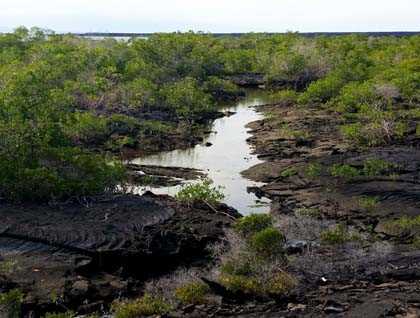Our day started with a dry landing over the black lava fields of Fernandina. After being welcomed by large clusters of large marine iguanas basking themselves on the rocks, we headed off for a long hike throughout the lava rocks, known as “pahoe-hoe” and “ah-ah” in this case. The scenery was remarkable, with this single active volcano from this young island displayed majestically in the distance.
Fernandina is less than a million years old, and it is very unique in that it is still largely pristine. Hundreds of marine iguanas were lying around, warming themselves on the lava rock, while some others were grazing on the green algae nearby. We also saw many Sally Lightfoot crabs and lava lizards along the intertidal zone, and even a few flightless cormorants that were preening and drying their feathers by exposing them to sunshine.
It was fascinating to be able to observe the marine life as well. We spotted two sea turtles swimming in the bay, three sea lions playing around the tide pools and up to five baby marine iguanas. The opportunity to disembark in such a remote and active area reminded us of the beauty and also the fragility of untouched scenery, and the importance on preserving this incredible ecosystem.
During the afternoon, our guests had the opportunity to experience the underwater realm, either through deep water snorkeling or on a Zodiac ride along the flank of Ecuador Volcano, on Isabela Island. Both excursions were a delight, and we saw dozens of sea turtles. Our naturalists explained how the marine ecosystem works, with the oceanographic dynamic and the currents determining the productivity in the trophic chain. Due to the cold masses of water influencing this side of the archipelago, the western islands are a perfect area to observe endemic species like the Galapagos fur seals and the little Galapagos penguins.
This was a fantastic day full of wildlife encounters, and we cannot wait to see what tomorrow has in store for us!







